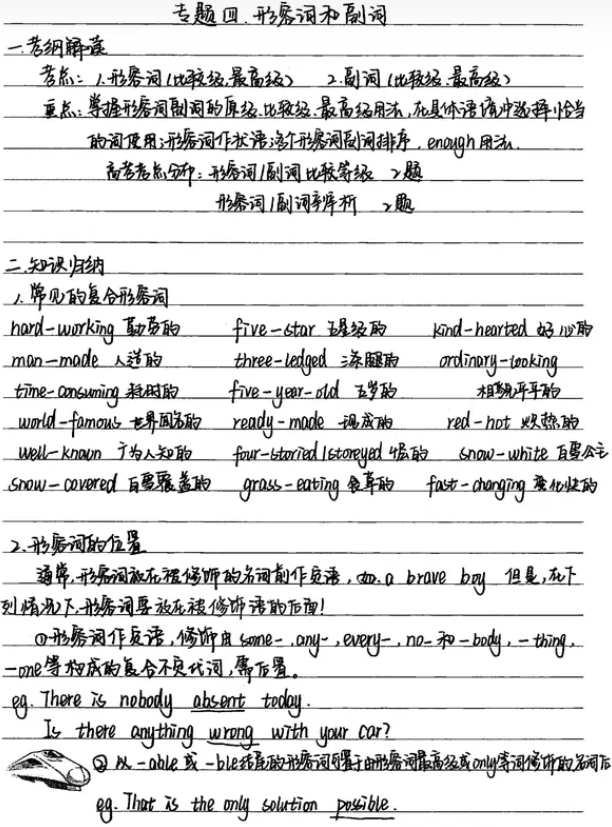其实学习本是一件快乐的事,只要你用心对待,你便会发现其中的乐趣,所以不要把学习当做一个负担。俗话说的好,天生我才必有用,千金散尽还复来!所以不要放弃学习,以下是小编给大家整理的高一英语上册知识点。希望大家能够喜欢!
一. 直接引语和间接引语
(一)直接引述别人的原话,叫做直接引语;用自己话转述别人的话,叫做间接引语。间接引语一般构成宾语从句。直接引语必须放在引号内,间接引语则不用引号。直接引语改为间接引语时,除将引语部分变成宾语从句外,还必须对直接引语中的人称、时态、指示代词、时间状语、地点状语等进行改变。
1. 时态的变化:直接引语变为间接引语时,通常受转述动词said,
asked等的影响而使用过去化的时态,即把原来的时态向过去推,也就是一般现在时变为一般过去时,现在进行时变为过去进行时,等等。例如:
Tom said to me,“My brother is doing his homework.”
→Tom said to me that his brother was doing his homework.
2. 人称代词、指示代词、时间状语、地点状语等等的变化: 根据意义进行相应的变化,例如:
She asked Jack,“Where have you been?”
→She asked Jack where he had been.
He said,“These books are mine.”
→He said that those books were his.
(二)直接引语改为间接引语时,都使用陈述语序,但是因为原句的句式不同,所以变成间接引语时所用的连词会有所不同。直接引语如果是一般疑问句,用连接词whether或if;如果是特殊疑问句,则用疑问词引导间接引语。转述的动词一般用asked,可以在其后加上一个间接宾语me,
him, her, us等。如:
She said,“Is your father at home?”
→She asked me if/whether my father was at home.
“What do you do every Sunday?”My friend asked me.
→My friend asked me what I did every Sunday.
直接引语如果是祈使句,改为间接引语时,要将祈使句的动词原形变为带to的不定式,并在不定式的前面根据原句的语气(即请求或命令)加上ask, tell,
order等动词,如果祈使句为否定式,则在不定式前加not。其句型为:ask / tell / order someone (not) to do
something. 例如:
She said to us,“Please sit down.”
→She asked us to sit down.
He said to him,“Go away!”
→He ordered him to go away.
He said, “Don’t make so much noise, boys.”
→He told the boys not to make so much noise.
二. 各种时态的被动语态
被动语态概述
被动语态的概念:它是动词的一种形式,表示主语与谓语之间的执行或被执行关系。主动语态表示主语是谓语动作的执行者,例如:They saw the
little boy crying by the river. 被动语态表示主语是谓语动作的承受者,例如:The little boy was seen
crying by the river.
被动语态的构成
被动语态的形式是由“助动词be+动词的过去分词”构成。助动词be随着主语的人称、数、时态等的不同而变化。几种常见时态的被动语态形式如下:
1. 一般现在时 am/is/are + 过去分词
例如:Rice is planted in the south of China.
2. 一般过去时 was/were + 过去分词
例如:These trees were planted the year before last.
3. 一般将来时 will/shall + be + 过去分词
例如:A sports meeting will be held next week in our school.
4. 现在进行时 am/is/are + being + 过去分词
例如:Your radio is being repaired now.
5. 过去进行时 was/were + being + 过去分词
When he got there, the problem was being discussed.
6. 现在完成时 have/has + been + 过去分词
His work has been finished.
Has his work been finished? Yes, it has. / No, it hasn’t.
7. 过去完成时 had + been + 过去分词
注意:
1.除了be之外的其它系动词如get, stay等也可以和过去分词构成被动语态。例如:Their questions haven’t got
answered.
2. 含有情态动词的谓语变成被动语态使用“情态动词+ be + 过去分词”结构。例如:
More attention should be paid to the old in this country.
This work can’t be done until Mr. Black comes.
3. 含有“be going to”, “be to”等结构的谓语,其被动语态分别用“be going to + be + 过去分词”和“be to
+ be + 过去分词”。例如:
The problem is going to be discussed at the next meeting.
All these books are to be taken to the library.
4.
被动语态与系表结构的区别:“连系动词+用作表语的过去分词”构成的系表结构,与被动语态的形式完全一样,所以应注意它们的区别。被动语态中的过去分词是动词,多强调动作;系表结构中的过去分词相当于形容词,多强调状态。前者通常可用by
引出动作的执行者,而后者则不可以。例如:
The map was changed by someone.(被动结构)
That custom remained unchanged for many centuries.(系表结构)
系表结构中的过去分词通常可被very修饰,被动语态中的过去分词往往要用much修饰。
例如:
He was very excited.(系表结构)
He was much excited by her words.(被动结构)
5. 主动形式表被动意义。有些动词的主动形式有被动意味,如 open, read, sell, shut, wash, wear,
write等。此时句子的主语一般是物。例如:
These books sell well. 这些书很畅销。
The door won’t shut. 这门关不上。
The clothes wash well. 这些衣服很好洗。
高一英语上册知识点2
1.基础梳理
actor quality active republic principle mankind period guidance fee youth
league stage vote generous selfish selfless devote violence equal blanket
educated relative terror cruelty opinion invader judge quote be sentenced to
nationalism blow up as a matter of fact out of work come into power
2.词语归纳
1)quality
表示“品质,品种”时,可有复数形式。
of quality修饰人,表示“品质好的”。
说明商品时,为不可数名词,表示“质量”;作名词复数时,表示“性能,种类”。
2)willing
表示“乐意的,愿意的”,作表语时,后接不定式或者是that引导的从句,从句中用should+动词原形,should可以省略。
有时willing可以用在seem,look,sound等系动词后面。
作定语时,表示“积极的,肯干的,自愿的,意志坚强的”。
3)fight
fight against… 为……反对而斗争,和……作战 fight with和……作战或者斗争,与……并肩作战 fight for
为……斗争或者奋斗 fight over 为……争吵 fight(it)out 通过斗争解决,打出个胜负
4)advise
advise sb to do sth 劝告/建议某人去做某事 advise sb not to do sth=advise sb against
doing sth 劝告/建议某人不要去做某事
advise后接一个宾语从句,从句中的动词要用虚拟语气,即should+动词原形,should可以省略。
advise sb of sth 把某事通知某人
advise sb on/about sth 和某人商量某事
5)youth
表示“青年男子,青年小伙子”时,是可数名词,常含贬义。
the youth 青年人的总称,作主语是,谓语动词可是复数也可是单数。
表示“青春,青少年时期”是不可数名词。
6)vote
作名词,表示“选举,投票,表决”时,前面常加不定冠词。
bring/put/submit sth to a/the vote 将某问题交付表决(表主动)come/go to a/the vote
(某问题)被交付表决(表被动)
表示“选票,选举人“时,是可数名词。
表示“选举权”时,前面常加a,the,one’s等限制词。
vote for 投票赞成,建议 vote against 投票反对 vote on 对……表决 vote to do 一致决定
7)position
表示“位置,姿势,职位,立场”时,是可数名词,常加in。
表示“地位”时,是不可数名词,有时可加不定冠词。
in a position to do sth处于能够做某事的地位 in/out of position 在(不在)适当位置
take up the position that… 主张……
8)accept
表示“同意,接受”时,后接名词,代词或者that引导的从句。
accept还可以接不定式。
9)equal
作形容词,与to连用,后接名词或者动名词,表示“能胜任的,能应付的”。
作动词,后接in,表示“在某方面比得上或者敌得过”,多用于一般时。
10)degree
表示“程度,等级,学位,度数”。
by degrees 渐渐地 to a degree非常;有点,稍微
do/study for degree 攻读学位 take/get/receive/earn one’s degree获得学位
11)guard
作名词,表示“守望,警戒”。既可以作个体名词,表示“警卫,卫兵,哨兵”;表示“卫队,警卫队,仪仗队”也可以作集体名词。
keep/stand/mount guard over… 守卫…… be on guard against 提防,谨慎 off one’s duard
失去警惕
作动词表示“保护,防止,看守,警惕”,常与against或者from搭配。
12)fear
作名词,表示“恐惧,顾虑或者担心的事情,可能性”。
for fear of/that 唯恐,以免 of后接名词,动名词;that后接从句。
作动词,表示“害怕,畏惧,恐怕”。后接名词,动名词,不定式或者从句。
fear for 担心
13)reward
作动词,表示“报酬,酬谢,报答,奖赏”。接介词for表示“缘故”。接介词with表示奖赏的东西。
作名词,表示“报酬,酬谢,报答,奖赏”。
as a reward for 作为……奖赏,为酬谢…… in reward of (以……)酬谢
in reward 作为报酬
表示好处,回报时,常常用作复数。
14)sentence
作动词,sentence sb 判决某人,后接介词to+名词,也可以接不定式。
15)trouble
作名词,既可以是可数名词也可以是不可数名词。
in trouble 处于困境 no trouble 不麻烦,不费事 ask for/look for/borrow trouble
自讨苦吃,自找麻烦
be a trouble to sb 对某人来说是个麻烦 be a trouble to do sth 干某事时间麻烦事
have trouble doing/to do sth 做某事很费力 make trouble 制造麻烦
get into trouble 陷入困境 get out of trouble 摆脱困境
give sb trouble/put sb to trouble 给某人添麻烦 trouble to do 多用于否定句或者是疑问句
16)set up
表示“建立,开创;竖起;创纪录”。
set(oneself)up as 开始当…… set out 动身,出发;开始 set about 开始;着手 set off 动身;使爆炸 set
down 记下来,写下来
17)blow up①爆炸,炸毁②吹胀③训斥批评
blow away 枪杀,彻底战胜 blow in 不期而至 blow out 吹灭 blow off 不重视 blow over刮倒
18)lose heart
lose one’s heart to… 爱上 break one’s heart 伤心 from the bottom of one’s heart
从内心里
put one’s heart into 全心全意
19)倒装结构的用法:
一、副词here,there, in, out,up ,down, away,back,now, then, ahead
等位于句首,当谓语动词是be,come, go, follow,run等表示位置移动的动词,而且主语又是名词时,需要把谓语动词放主语之前,即全部倒装。
注意:A 此类倒装不用进行时态度。B若主语是代词时,不用倒装。
二,含有否定意义的词放句首,部分倒装。
A具有否定意义的副词放句首: not,never,seldom,hardly, rarely.little,scarely,few…
B,含有否定意义的连词放句首:not only…but also.., neither..nor.., no sooner…than..,
scarely..than..,Hardly..when.., not until…
_not only, no sooner,hardly.scarely要倒,but (also), than, when后面的句子不倒.
neither..nor..两部分都倒装。
C, 含有否定意义的介词放句首:by no means, In no time,in no case, on no account,under no
circumstances…
三,only+状语,部分到装
四、表示上文的状况也适合另外一人或事半功倍有下列:
肯定:so+助动词(动/情态)+主语 _主语与上文一致
否定:neither(nor)+助动(动/情态)+主语
五、as 作“尽管/虽然”,引导让步状语从句,由于语法需要,把表语/状语/动词提于句首.
六、so ..that.., such ..that..的句子结构中,若so,such 和与其所修饰的词置于句首,实行部分倒。
七、若if 引导的虚拟条件句中有were, had, should 时, 可将if省,把were, had , should 放主语之前。
八、充当地点状语的介词短语放句首,全倒。
九、在表示愿望的感叹句,倒装。
十、There be 句型。
高一英语上册知识点3
重点短语:
1. get sb interested in 使某人对……感兴趣
2. the best way of doing sth/the best way to do sth 干…的方法
3. care about 关心;忧虑
4. care for/to do sth 希望或同意做某事
5. give in 投降;让步
6. make camp 野营;宿营
7. dream of doing 梦想做某事
8. persuade sb into/out of (doing) sth 说服某人做某事/不做某事
9. try to persuade sb to do 尽力说服某人做某事=advise sb to do sth
10. insist on sth/doing sth 一定要(某事);坚决主张
11. make up one's mind 下定决心
12. put up one's tents 搭起帐篷
13. set /break(beat)/hold a record 创造/打破/保持记录
14. have a dream of sb/sth/doing sth 梦见某人/某物/梦想……
15. dream of/about… dream a dream
16. be determined to do sth 决心干某事 (表状态)
17. determine sb to do sth 使某人下决心做某事(表动作)
18. sb be familiar with sth 某人熟悉某物
sth be familiar to sb 某物被某人所熟悉
sb be familiar with sb 某人与某人亲密无间
19. A be similar to B A与B相似
20. read one's mind 看出某人心事
take one's mind off sth 转移注意力
keep one's mind on sth 把注意力放在…
keep/bear sth in mind 记住…
She has many problems on her mind 她心事重重
21. give in to sb 对某人让步
give away 赠送
give off 放出(液体、气体、气味、光、热量)
give out 分发
give in 放弃









请先 !